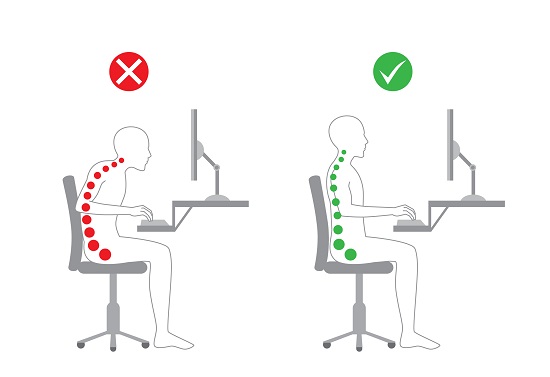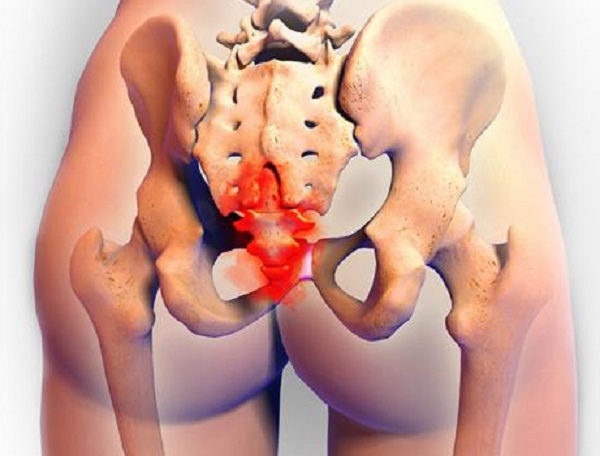What if one day, for no apparent reason, you started having pain when you tried to sit? No injury proceeded this – no fall, no sexual trauma, no infection. Just a seemly random, inexplicable pain at your tailbone in sitting.
I hear this frequently from patients seeking treatment for coccydynia, or tailbone pain. They arrive to my office confused and frustrated. Pain may have started after prolonged sitting, bike riding, or sitting in a hard seat for too long, but these activities were nothing new in their lifestyle. Paradoxically, it may hurt worse on both hard chairs and sofas. Perhaps it hurts worst when trying to stand-up, or perhaps it forces them to shift from buttock to buttock to avoid the pain point. It just doesn’t add up.
While coccydynia can certainly arise after an acute injury, it often occurs without a known cause (read more here). Common solutions offered are donut pillows, NSAIDS, and cortisone injections. Even with these interventions the recovery process can be long and slow, because our day-to-day life typically requires near-constant sitting. We sit to eat, sit to drive, sit to talk on the phone and work on the computer, and sit to relax in the evening. These daily activities irritate the already sensitive pain points, and contribute to a very slow recovery.
What I have found is that in some of my patients, sitting is not just a symptom provoking position. It is actually the primary irritant that caused their pain in the first place. More accurately, the WAY they are sitting is what is causing their pain.
Sitting Posture and its Connection to the Tailbone
Appropriate sitting posture involves placing body weight on the sit-bones (ischial tuberosities) and thighs. This requires an upright posture and slight lower back arch known as “lumbar lordosis.”

Poor sitting posture happens when we round our lower backs, slouching into the chair. It’s often the position we end up in and here are three common reasons:
- First, it may be most relaxed position to sit in because many chairs encourage it. Car seats are sometimes “bucket” shaped, promoting a C-shape when sitting. Airplane seats are notorious for this as well. Couches are soft and low, leaving you no option but to slouch backwards.
- Second, when we are sitting we are usually reaching forward to type, read, eat, or drive. As we lean forward to reach whatever we are working on it is very easy to round the upper back, leading to a rounded lower back as well.
- Lastly, sitting with appropriate posture requires work! Our muscles must be active to support the spine, whereas slouching backwards lets us rely on the chair for passive support. As most of us sit for the majority of our day, it is easy to get lazy and slouch rather than work to stay upright. Over time we get so accustomed to this position that it can be a real challenge to change.
How does slouching in your chair affect the tailbone? Take a moment to feel for yourself. Sit on a firm chair and place your hands under your sit bones. First arch your back and lift your chest, feeling the weight shift forward to the sit bones and thighs. Your weight is moving forward, AWAY from the tailbone. Now place a hand over your sacrum and coccyx and allow your lower back and shoulders to slouch. Feel that all of your weight moved back, behind the sit bones, and may be directly on your tailbone. The tailbone and sacrum are not meant to support the body weight in this way, and this position can irritate the tailbone joint (sacrococcygeal joint) and surrounding soft tissue.
The more rounded your spine becomes in sitting, the more pressure rests directly on the sacrum and coccyx. This is why low soft surfaces such as sofas can sometimes be the most irritating. Of course, hard chairs will also be uncomfortable because it’s a firm pressure on an irritated joint and muscles.
What about pain at the tailbone that happens when moving from sitting to standing? This is typically a result of your buttock muscles pulling on the tailbone as they contract to lift you off the chair.
And why do you find yourself constantly shifting back and forth? This is your body’s instinctive way of trying to take pressure off of the tailbone. Unfortunately it’s hard to get comfortable in these positions and they can lead to other aches and pains in the hips, back, shoulders, and neck.
Fortunately there are several solutions to help address this issue! And if after implementing them you are still having trouble, physical therapists such as myself specialize in treatment of this area.
Inflammation Control: Chair Padding and Ice
The first step is to help your body heal the current inflammation, while at the same time removing stressors that might cause continued irritation.
I recommend a wedge-shaped cushion, with a coccyx cut out, rather than a donut. The wedge shape facilitates proper spine position and makes it harder for you to slouch. As you now know, slouching is one of the major factors in irritating a sensitive tailbone. Specific product recommendations can be found here.
Some patients also like to ice their tailbone area to manage discomfort. If you would like to use ice I recommend the snack-sized plastic bags, filled half way with water, and frozen. Then wrap it in a moist paper towel to protect your skin (this area is sensitive!) and allow it to sit on the skin over the tailbone, just inside the crevice between your buttocks. You can also ice over the sacrum, again being careful to protect your skin.
If you have any broken skin, skin irritations, fragile skin, decreased sensation or blood flow, or other contraindication, then don’t use ice.
Maintain Healthy Sitting Posture
For long term healthy sitting, adjustments must be made to your habitual sitting posture. Here are some suggestions to help your body get used to the new position if you are having trouble.
A wedge-shaped cushion under the buttocks should be paired with a lumbar support roll. This doesn’t have to be expensive- a rolled up bath towel will do the trick. To arrange yourself in the chair, first place the wedge cushion all the way to the back-rest. Sit on the cushion all the way at the back of the chair, and then place the lumbar roll in the lower back. It should provide gentle but firm support so that your lower back has a natural curve but isn’t having to work to maintain it. Then as you sit make sure your shoulder blades stay in contact with the chair back. This set up typically ensures that your body weight is on the sit bones and thighs, rather than sacrum or coccyx.
Your next step is to re-arrange your environment so that it facilitates your sitting position, rather than pulls you out of it.
In the car, for example, find your perfect sitting position including cushion, lumbar support, and upright seat angle so that your shoulder blades are touching. Then adjust all of your mirrors so that if you deviate too far from this position you will no longer be able to see. Now your environment is facilitating appropriate posture rather than challenging it! A special note on car set-up is to check your headrest. If it is too far forward it will push your head forward and force you to round your back.
The same can be done in your work space. Elevate your computer screen so that it is at eye level and directly in front of you. Now if you slouch you won’t be able to see as well. Move your mouse-pad so that you can reach it without losing upper back contact, place a stool under your feet or raise your chair- whatever needs to be done so that your surroundings reinforce your good posture. Your work station should adjust to you, not the other way around.
What about couches? How can you make your favorite low, saggy, soft TV watching spot into a healthy seat for your tailbone? Sadly you can’t. I recommend sitting up as straight as you can, semi-reclining on your side, or lying down completely.
Additional Considerations
What if you are having pain when you move from sitting to standing? As mentioned previously, this is likely coming from the pull of your buttock muscles on the tailbone as they work to help you stand up. In addition to adjusting your sitting posture to relieve stress from the joints, you may also need to stretch, strengthen, or release trigger points in your hip muscles. I highly recommend professional evaluation and treatment in order to learn how to safely and effectively do this.
The ideas that I have discussed here also apply to people with tailbone pain resulting from a fall or other trauma (in fact, I teach all my patients with tailbone pain these strategies because they are truly that important). However these cases may require additional treatment to improve joint positioning and mobility, as well as treat the muscles and connective tissue surrounding the tailbone. I discuss this in Part 1 of this series Here.
How Long Until I Feel Better?
Because of how many hours per day we sit, it may take some time for your irritation to fade, even if you are maintaining perfect sitting posture at all times. Even after your discomfort decreases you may still have flare-ups, and you should always try to maintain good sitting posture to keep pain from returning.
Fortunately good sitting posture benefits many other aspects of your body. You may find that lower back pain, shoulder blade discomfort, neck stiffness, and headaches all improve as well.
No matter why your tailbone started hurting, I always recommend being evaluated by a physical therapist experienced in treating coccydynia. They can ease your fears by determining exactly what is causing your pain and recommending specific, personalized steps to heal it. coccyx.org is a great resource, with a practitioner directory as well as extensive resources on the diagnosis. You can also read Part 1 of this series, Often Injured Rarely Treated: Coccydynia.
We Need Your Help
Hormones Matter needs funding now. Our research funding was cut recently and because of our commitment to independent health research and journalism unbiased by commercial interests we allow minimal advertising on the site. That means all funding must come from you, our readers. Don’t let Hormones Matter die.
Yes, I’d like to support Hormones Matter.
Image by fairpharma from Pixabay.













Hi, my name is Denise. I broke my tailbone when I was 5 yrs old. Now at 60, I am learning to play the piano. I have this problem though, when I sit for more than 15 minutes, my tailbone begins to go numb and so do my feet. The stool has to be in the right position to play the piano. I don’t know how to get around it. Would you have any suggestions? After this many years, I am sure I have some serious scar tissue and I don’t want to go see a doctor about it, just looking to see if you may have any tips that might help. Thank you for your time.
Great tips! As another resource we love Dr. Foye’s Book, Tailbone Pain Relief Now! We aren’t affiliated with him in any way, just found the book helpful. How do you feel about standing desks as a way of preventing pain from sitting?